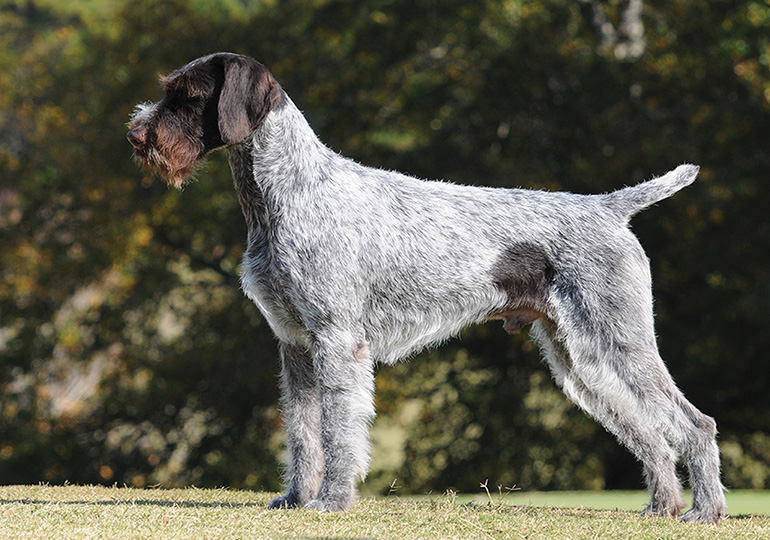German Wirehaired Pointer
Breed Details
Size:
Exercise Requirements:
Grooming Requirements:
25-36 Kg (Approx)
12-14 years (Approx)

Appearance
The German Wirehaired Pointer is a well muscled, medium to large-sized dog of distinctive appearance. Balanced in size and sturdily built, the breed's most distinguishing characteristics are its weather resistant, wire-like coat and its facial furnishings.
The German Wirehaired Pointer, also known as the ‘Drahthaar’, is a pointing dog that shares the German Shorthaired Pointer’s noble appearance. It has a thick, wiry outer coat, however, which is two to four centimetres long. The coat protects the skin from extreme weather and the dense cover it sometimes has to work in, as well as insulating the dog when it retrieves in freezing water.
This breed is also built for strength, endurance and speed. Their movement should be powerful, ground-covering, flowing and harmonious.
Accentuated eyebrows and a strong, harsh-as-possible beard emphasise the GWP’s facial expression, which reflects their hunting style. Determined hunters, German Wirehaired Pointers will trail, hunt and find game, and will point and subsequently retrieve both wounded and dead game.
Ability in the field, natural intelligence and a biddable nature make these dogs much sought after hunting and family companions.
Colours are Brown roan with or without patches. Black roan with or without patches. Brown with or without white chest patch. Light roan. No other colour permitted.
History
German Wirehaired Pointers trace their origins back to 1880. They originated in Germany, where breeders wanted to develop a rugged, versatile hunting dog that would work closely with either one person or a small party of persons hunting on foot in varied terrain; from the mountainous regions of the Alps, to dense forests, to more open areas with farms and small towns. The breed the Germans desired had to have a coat that would protect the dogs when working in heavy cover or in cold water, yet be easy to maintain. Careful crosses of the German Pointer with many other breeds. Sources differ on the exact lineage, though the Wirehaired Pointing Griffon, Pudelpointer, Stichelhaar, and Deutscher-Kurzhaar are commonly accepted as the most likely contributors. This is a dog that can fully respond to the needs of its hunter. The goal was to develop a wire-coated, medium-sized dog that could; Search for, locate and point upland game. Work both feather and fur with equal skill and retrieve water fowl. Be a close-working, easily trained gun dog. Be able to track and locate wounded game. Be fearless when hunting "sharp" game such as fox. Be a devoted companion and pet; and be a watchdog for its owner's family and property.
Temperament
Both German Wirehaired and Shorthaired Pointers are very loyal and family orientated and are well-suited to being treated as a family member. German Wirehaired Pointers can be aloof and protective of their family, but do accept visitors willingly.
Often referred to as the clown of the Gundog group, the German Wirehaired Pointer has a wonderfully endearing nature. Easy to train, they are extremely intelligent and should never be aggressive or shy.
Care/Grooming
The German Wirehaired Pointer coat does not shed, so needs regular stripping. Thankfully, the availability of excellent grooming tools makes it easy to keep the coat in shape.
Of course, show dogs need hand stripping only, so as to keep the coat’s harsh texture, but pet German Wirehaired Pointers may be trimmed and bathed in the same way as any other dog.
This breed’s ears and feet need particular attention. Owners need to take care to keep the hair stripped out of the ear and keep the ear clean and dry, while hair on the feet needs to be trimmed, particularly when the dogs have been in paddocks or dams. Keeping this hair trimmed will prevent mud collecting between the toes.
Feeding a good quality premium dry food, along with occasional raw meaty bones, will help keep both breeds’ teeth in top shape.
Breeders
Currently no Breeders in SA for this Breed

